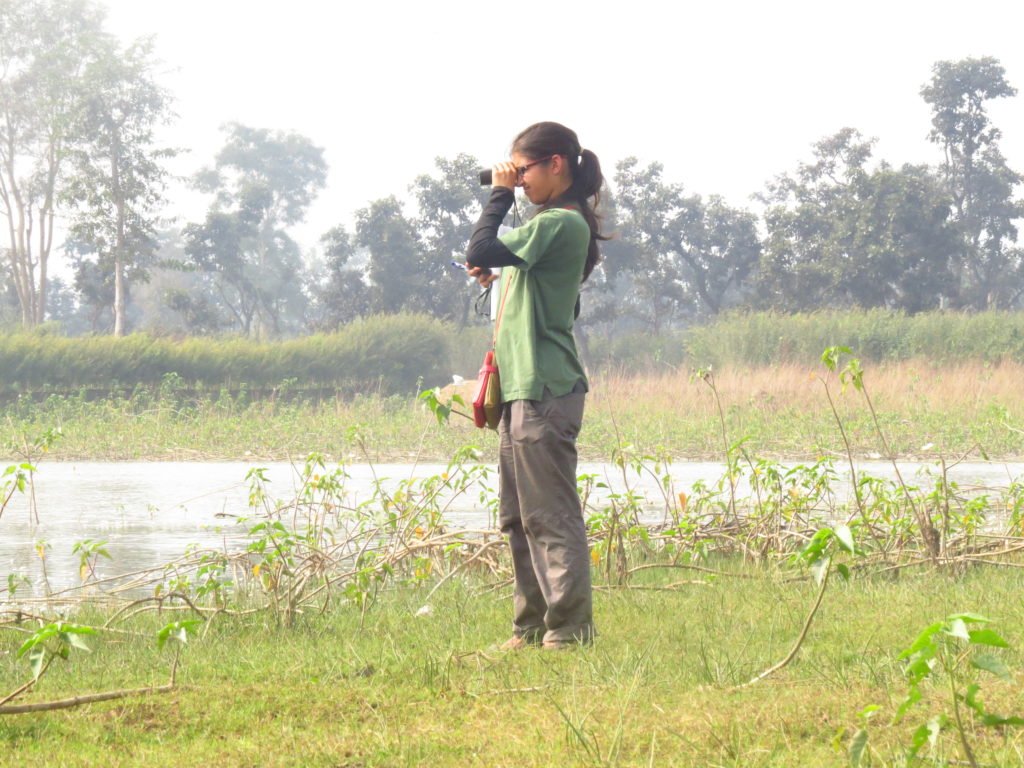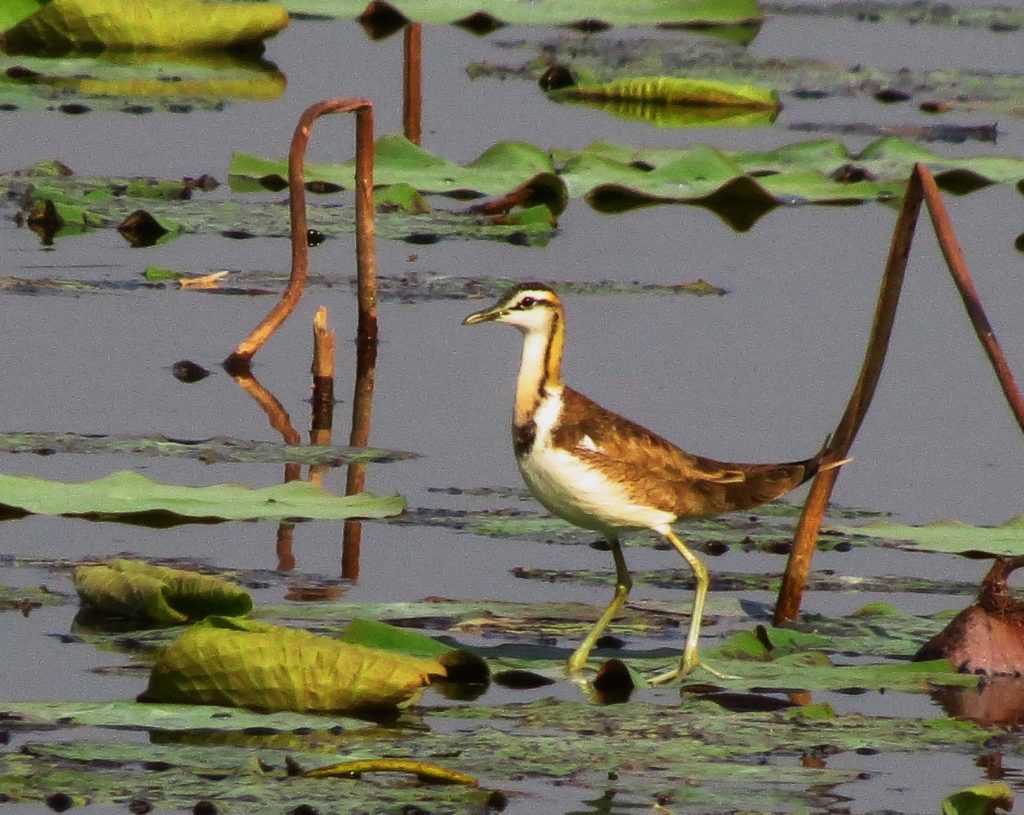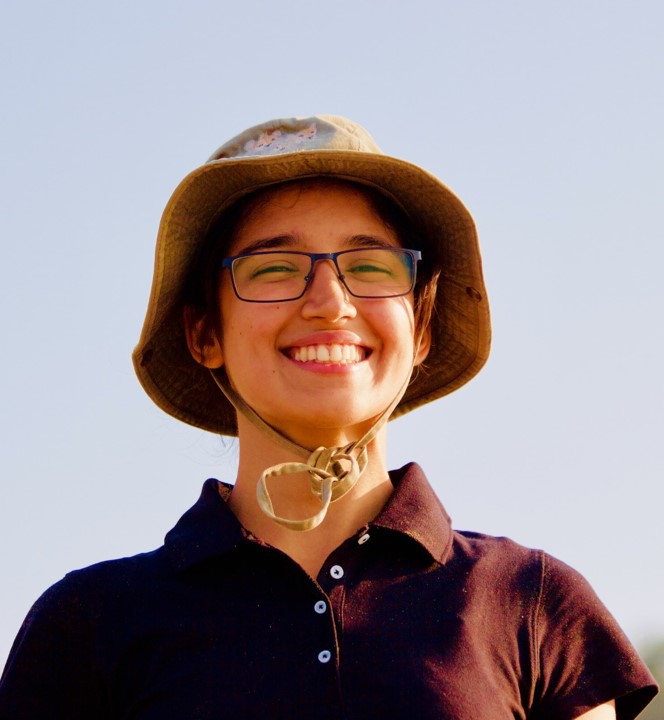I remember being in Honnavar, a coastal city on the estuary of the river Sharavathi, after a long day of field work of fish sampling. It was a long, hot, sunny day – our nets kept drifting with the tide and our catch was frustratingly low. As my fisher colleague, Shankar, was pulling in the net, we noticed a group of people with sticks huddled around something small and black. On a closer look, they were poking a Black-crowned night heron (Nycticorax nycticorax) with a stick to see if it would move. They had seen it escaping the mouth of a cat. Exhausted, it was valiant in its defence with its signature black mohawk standing up despite having a limp wing and being completely immobile. I had just completed a Master’s on wetland birds and their habitat but I lacked the knowledge to rescue a large strong heron – a very humbling realisation. Shankar was confident we could nurse it back to life. We learnt a few things by spending one week with this vivacious bird, and me frantically reading scientific papers on raising herons in captivity. Despite the existing knowledge, we had to figure out creative ways to make sure we had the best chance at this rescue. The bird had gangrene and needed antibiotics – which I could only get at the veterinary hospital that dealt with four-legged bovines. Luckily no bones were broken. It was encouraging that “our” heron responded well to a three day course and gained energy. Of course, we could no longer call it “our” heron, so I christened it with a name that stuck – “Baba Birdie”. I learnt (after much ridicule) that spending money at a fish market to buy fresh sardines was a sunk investment as this cuisine was deemed unpalatable by my feathered guest. Naturally, I was worried about how weak it was getting and I could not leave it alone. It was then that Shankar and I came up with an idea to have “Baba Birdie” accompany us to the field. We designed a leash with a shoelace, tying one end to a rock and giving it some time and fresh air by the river in the hope that it would regain its spirits. We noticed that it made several attempts to catch prey but did not have any successes. This is when it dawned on me that we could feed it live fish or perhaps a dead fish to imitate a live one – and voila! We managed to feed it with fresh loaches, wild carps, and got lucky with a few fish market leftovers, approximating 6-8 fish of at least 3 species per day! As it gained energy it also had its defences manifesting more readily than ever before, once almost making me lose an eye!I also got more adept with its ways as I learnt to approach it from the back and restrain its beak with my hair ties when it was time for a visit to the vet. Due to its renewed strength and speed, we also increased the length of its leash. Being nocturnal (yes, calling all night), it started trying to take off from its feeble basket walls that overturned with every attempted takeoff. The next time I went to sample at a mangrove patch I knew that it was time to let go. Plus, I was done sampling fish and could not justify staying in the field any longer. I let Shankar release it. As much as he had begun to despise handling our feisty “birdie”, it was this renewed vigour and its quick transition into the mangroves that made Shankar hopeful that this resilient bird would survive. In retrospect, I wish I was better trained to handle this bird from the get-go but I was not alone. I received a lot of help from experts in Bangalore, Pune and Kumta as we problem-solved together. We were all invested in one goal – the recovery and successful rehabilitation of this beautiful bird. It also made me think carefully about when it was okay to pursue a rescue – there is a fine line between nature taking its course and saving the last of the remaining wildlife we have.
This is how my interest in birds took shape..
I grew up in a part of Pune that was crowded and mostly devoid of trees. I had no eye for birds apart from the sparrows that my aunt used to leave seeds out for. I had adventurous family friends who took me rock-climbing, trekking, rappelling, and camping. It was my uncle, Dinshaw Eduljee, who made me notice my surroundings and have a deep respect for nature. He got me hooked on pursuing activities outdoors in a safe manner. At 15, I went on my first camp with a local tourism company, Pugmarks Holidays, and shared a tent with an aspiring wildlife biologist. It took a lot to convince my parents to let me go but my instructor made my parents feel at ease instantly. While this camp was mostly for kayaking, my instructor, Pooja Rathod, would bring geckos to our tent, hold spiders in her hands (to my dismay!) and make me watch fish swim in pools along the Ganges. I was fortunate to go on another camp with her to Corbett Tiger Reserve where she pointed out over 80 species of birds, our most memorable sighting being the Collared Falconet. Camps did turn out expensive but I learnt from my friend, Pratik Joshi, that one can experience nature in Pune (often close by and at no cost!). He was (and remains) in my mind a bird whisperer. One day, I accompanied him to an abandoned stone quarry, Sinhagad valley, and spots along the Mula-Mutha river that were teeming with migratory species. However, as I saw more sites and more birds it also meant encountering lots of garbage and I would pick up trash wherever I went in my subsequent visits. During my time spent in Fergusson college, I read Gerald Durrell novels, Jim Corbett’s series, and progressed on to reading books by Rachel Carson, K. Ullas Karanth and George Schaller. My classmate, Avik was sure he wanted to pursue a career in the wildlife sciences and I tagged along on trips to photograph snakes, birds, insects and honestly anything he found beautiful. Eventually we would accompany biologists on research projects on cetaceans, ephemeral plants, carnivores, etc. I had heard about the Student Conference on Conservation Science and after I attended the conference and met the fascinating people there I was sure that I wanted to pursue a career in wildlife sciences.
 Conducting point counts in ancient irrigation tank systems in Gondia, Maharashtra
Conducting point counts in ancient irrigation tank systems in Gondia, Maharashtra
It is very hard to tell when my passion for wildlife turned into a research direction. I always thought wildlife was something I am interested in but that I would focus on mitigating water pollution: on improving the water quality of the Mula-Mutha river. Little did I know that mitigating pollution and conserving wild species can be very related fields. I began volunteering on research projects initially because it was an inexpensive way to spend long periods of time in nature learning with people who had similar interests as me. The turning point for me was when I was volunteering on a Rufford funded project by Mayuresh Gangal, on the impact of fisheries on fish demographics along the Konkan coast. I also worked with members of the Konkan Cetacean Research team who inspired me to pursue a career in wildlife sciences. Mayuresh was trained in Wildlife Biology and Conservation at the National Centre for Biological Sciences and had a scientific approach to most things in life. I had to do an undergraduate research project but was unsure of what I would work on except that I really cared about solid waste impacting bird habitat on the Mula Mutha river. Through his mentorship, I was introduced to concepts on study design, bird sampling protocols, and handling field logistics. At my second SCCS conference I attended workshops on study design and raptor conservation by leading scientists. Eventually, I conducted a small project along a gradient of garbage cover on the Mula Mutha river. I even managed to secure funding from a travel and tourism company and hired a field technician, Rehan Hiroli, to help me conduct bird counts. Again, my parents were concerned for my safety travelling alone but my father supported me by accompanying me to all my bird counts at 7 am. I often missed classes at Fergusson college, which deeply upset my professors until they were convinced that I had whole heartedly put my time in research and that I would make up for lost classes by conducting all my environmental science practicals before the finals. We had a small thesis defence and although now I can see the limitations of the study, at the time it was well-received, galvanising my interest in undertaking independent research. I too ended up pursuing a Master’s at the National Centre for Biological Sciences- WCS-India program where my budding research capabilities were transformed into several technical and behavioural skills to conduct research in any natural environment. I conducted my Master’s thesis on the influence of aquatic vegetation on bird communities in ancient irrigation tanks called Maaji-Malgujjari Talaos in Central India. I was introduced to these fascinating ecosystems by Dr. K.S. Gopi Sundar and Swati Kittur whose work was primarily based in the Northern Gangetic plains. It was through my Master’s field work that I learnt how limited our understanding of wetland birds are in general, and even more so in agricultural systems in South Asia. I wanted to continue this research but needed to learn the science of ecohydrology. Working as a Research Assistant at Dr. Krishnaswamy’s lab at ATREE cementing my professional aspirations to conduct research and conservation of India’s freshwater ecosystems.
I am currently pursuing a PhD at the University of Minnesota in Dr. Susan Galatowitsch’s research group. As I mentioned, I wanted to continue my research on waterbirds in agricultural systems. I particularly wanted to understand what conditions allowed birds to persist and whether there were any limitations or opportunities for bird conservation. My advisor was very supportive of the ideas and has helped me significantly in shaping them. While I was working in Vidarbha in 2015, I found that bird communities were the most diverse and abundant in sites with aquatic vegetation resplendent in some kinds of vegetation like water lilies and sedges. However, the results were mixed for other types of vegetation – meaning that while some birds could benefit from tall and woody invasive species, others were not found there. Overall, there was no reliable data pointing towards the conditions that woody invasive species could persist in as well as overall trends in their spread. I also found that several citizen science groups were interested in conserving waterbirds and some worked very hard to monitor and lobby for the conservation of Sarus Cranes in Gondia and Bhandara. In other areas of South Gondia, fishing cooperatives were restoring wetlands to improve fish production and women’s stake in fishing under the leadership of Manish Rajankar and Shalu Kolhe. So while there was this major interest in bird conservation, clearly these wetlands were important to various stakeholders and often for very different reasons. As part of Rashmi Mahajan’s PhD work at ATREE, several social dynamics of water sharing were unearthed in the southern parts of Gondia district which could also influence the habitat available to birds. I had also observed some of these social dynamics in relation to waterbird conservation particularly when summer was at its peak. This picture is etched in my memory – birds concentrated in locations with water, fishers harvesting their last fish catch of the year and farmers pumping water from the wetland. I wondered how these uses interacted to influence available habitat for waterbirds.
As part of my PhD dissertation, I am interested in understanding the potential and trade-offs for waterbird conservation in ancient man-made wetland systems. Drawing from the principles of ecohydrology and the emerging field of socio hydrology, I am using water regimes to understand the links between climate variability, waterbird habitat and human uses. Currently, Mrunali Raut and Kanhaiya Udapure are important members of my project as they have been collecting data on birds and making that data available on eBird throughout the pandemic. I hope that as part of my project, I can learn more about birds and their habitat with the help of a strong network of citizen scientists in the region and provide important information to local managers on maintaining habitats for waterbirds.
 A Pheasant-tailed Jacana guarding its territory on a water lily pad
A Pheasant-tailed Jacana guarding its territory on a water lily pad
I love what I do because..
If someone asked me the most favourite part of my work, without doubt I would say data collection and observation in the field. I find that being adept in one’s natural history can help one conceptualise more insightful research in conservation sciences. It also takes me back to the “why” of my work i.e. I do this research because I love being in nature and learning about relationships between humans, natural ecosystems and wildlife. Watching birds, whether it is an egret catching fish, watching a flock of geese take off, or observing cranes in their courtship – is a true privilege that I am grateful for when I am in the field. I feel very humble when I spend time talking to individuals who understand natural systems as part of their daily lives rather than purely for scientific pursuit. I am exposed to different cultures and learn new ways of navigating them to conduct field research and form meaningful connections with local and indigenous communities. I must add that through the course of my PhD I have enjoyed the challenge of integrating insights from the fields of wetland ecology, ornithology, human geography and hydrology to ask questions of an interdisciplinary nature that can be most useful for management. I am motivated to pick up new skills to problem-solve most things in my life which has allowed me to enjoy the process of conceptualising ideas for my PhD. While I am often exhausted by my screen time, learning remote sensing and applying it to gain insights on wetland hydrology has been exciting. In general, I feel very connected to nature, particularly, freshwater systems, on a spiritual level. Any opportunity to share the benefits of this connection through my work is one of the most enjoyable aspects of research.
The challenges I faced..
Doing a PhD comes with its own enormous territory of challenges for which there are dedicated websites – so I will not elaborate on those here. However, some challenges pervade through all spheres of life, naturally spilling over into the field of ornithology or ecology in general. First, want to get rich? Currently, I have not encountered well-paying jobs in research in general unless one reaches a very advanced stage – even then funding constraints are a real and pervasive challenge. In terms of field challenges, as a woman, I am constantly challenged to think of ways to be safe in the field or navigate different social practises. I remember dressing, speaking or behaving in ways that seemed inauthentic to me at the time but enabled me to succeed and adapt to that environment. For example, expectations from me changed drastically in the field based on my marital status and navigating that was a fine line between respecting the local culture and being authentic to values as an individual. I remember feeling that I was alone in these challenges but realising that I had support from a network of friends and colleagues has helped me tremendously. Additionally, if I am training someone new on a project I invest in these conversations to make sure that my field staff are well equipped to handle these challenges when they are suddenly confronted by them. In terms of challenges with ornithology, I encountered people who were mostly competing on how many species they could identify and I often fell into the trap of trying to prove myself constantly. Over time I have realised that so much of good research is done through collaboration and having a strong eye for patterns and processes. I often feel overwhelmed by the number of skills I need to carry out my research from coding, writing, and behavioural skills. But with time I am more aware of my strengths and limitations enabling me to ask for intellectual and personal support when needed. COVID has brought a lot of challenges to my PhD work as it has for many of my colleagues, but I have benefited tremendously from having open conversations with colleagues about mental health and investing in my own well-being to cope with these changes. Keeping my “why” alive in some way or the other has helped me through some pretty tough times in my work. Another massive challenge that I have had to navigate is the pain and anxiety from constantly having to assimilate information on the destruction of habitats either through the news or just returning to a habitat that I loved, only to find it completely destroyed. I think that working on my mental health has helped me drastically to separate myself from the situation and understand the extent of my control whether it is to unite and organise or accept that I have no control in avoiding a situation short-term.
My advice to young researchers is..
Each individual succeeds differently but here are some ways that have helped bring out my best work. My first piece of advice is to commit to a path of continuous learning. This might involve spending 30 min watching a documentary, reading a book, talking to someone more experienced, observing birds; whatever inspires you. Second, remember your “why” and take detailed field notes of observations that help strengthen your “why”. Let’s face it – I do not always enjoy my work. I too feel uninspired and unmotivated especially during phases of scientific writing. Staying connected to my “why” involves me spending time outdoors, watching birds wherever I am, reading books and engaging with people who inspire me. Third, accept that you won’t be good at everything but still try to be your best self. Research is not for the faint-hearted and requires hours of dedicated pursuit towards picking up many skills. Learn as much as you can but remember that you cannot possibly know everything – no one does even if they act like they do. Fourth, take the time to unwind. Most people who get into this field do not do it to get rich but for their love of birds and all things natural. The danger is that you can experience burnout and be vulnerable to abuse if you do not see yourself as a person first and ornithologist second. As Albert Einstein said “I cannot tell if I would have done any creative work of importance in music, but I do know that I get most joy in life out of my violin.” Another thing, which would seem basic yet is hard to do at times – be nice to yourself and to others. I take the time to continue dancing and picking up new hobbies – currently, figure skating.
Treat yourself and colleagues with respect, give credit where it is due, help people with resources like books and papers if you have them, know your biases and work on them. I know several amazing birders who do not speak English and have an excellent scientific temper. Recognize when someone is acting a certain way with you because of their biases. Know when you have the power to help someone in their work or influence an outcome in the field. I cannot emphasise enough the contribution colleagues have made in reviewing my drafts, sharing grant opportunities, offering empathy, brainstorming ideas, and most importantly offering commoradorie in our love for birds and science.
Shivona Bhojwani
bhojw006[at]umn[dot]edu
PhD candidate
Department of Fisheries, Wildlife and Conservation Biology
University of Minnesota
Instagram handle: @wetlands_of_india


Very good article and thank you for adding that part on how we can be ornithologist too. You’ve inspired me.